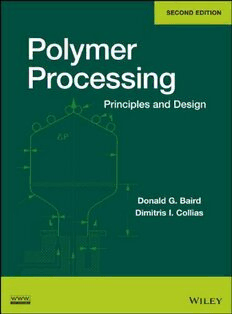Table Of ContentPOLYMER PROCESSING
POLYMER PROCESSING
Principles and Design
Second Edition
DONALDG.BAIRD
DepartmentofChemicalEngineering
VirginiaPolytechnicInstituteandStateUniversity
Blacksburg,Virginia
DIMITRISI.COLLIAS
Procter&GambleCo.
Cincinnati,Ohio
Copyright(cid:2)C 2014byJohnWiley&Sons,Inc.Allrightsreserved.
PublishedbyJohnWiley&Sons,Inc.,Hoboken,NewJersey.
PublishedsimultaneouslyinCanada.
Nopartofthispublicationmaybereproduced,storedinaretrievalsystem,ortransmittedinanyformorbyanymeans,electronic,mechanical,
photocopying,recording,scanning,orotherwise,exceptaspermittedunderSection107or108ofthe1976UnitedStatesCopyrightAct,without
eitherthepriorwrittenpermissionofthePublisher,orauthorizationthroughpaymentoftheappropriateper-copyfeetotheCopyrightClearance
Center,Inc.,222RosewoodDrive,Danvers,MA01923,(978)750-8400,fax(978)750-4470,oronthewebatwww.copyright.com.Requeststothe
PublisherforpermissionshouldbeaddressedtothePermissionsDepartment,JohnWiley&Sons,Inc.,111RiverStreet,Hoboken,NJ07030,
(201)748-6011,fax(201)748-6008,oronlineathttp://www.wiley.com/go/permission.
LimitofLiability/DisclaimerofWarranty:Whilethepublisherandauthorhaveusedtheirbesteffortsinpreparingthisbook,theymakeno
representationsorwarrantieswithrespecttotheaccuracyorcompletenessofthecontentsofthisbookandspecificallydisclaimanyimplied
warrantiesofmerchantabilityorfitnessforaparticularpurpose.Nowarrantymaybecreatedorextendedbysalesrepresentativesorwrittensales
materials.Theadviceandstrategiescontainedhereinmaynotbesuitableforyoursituation.Youshouldconsultwithaprofessionalwhere
appropriate.Neitherthepublishernorauthorshallbeliableforanylossofprofitoranyothercommercialdamages,includingbutnotlimitedto
special,incidental,consequential,orotherdamages.
Forgeneralinformationonourotherproductsandservicesorfortechnicalsupport,pleasecontactourCustomerCareDepartmentwithintheUnited
Statesat(800)762-2974,outsidetheUnitedStatesat(317)572-3993orfax(317)572-4002.
Wileyalsopublishesitsbooksinavarietyofelectronicformatsandbyprint-on-demand.Notallcontentthatisavailableinstandardprintversions
ofthisbookmayappearorbepackagedinallbookformats.Ifyouhavepurchasedaversionofthisbookthatdidnotincludemediathatis
referencedbyoraccompaniesastandardprintversion,youmayrequestthismediabyvisitinghttp://booksupport.wiley.com.Formoreinformation
aboutWileyproducts,visitusatwww.wiley.com.
LibraryofCongressCataloging-in-PublicationData:
Baird,DonaldG.
Polymerprocessing:principlesanddesign/byDonaldG.Baird,DepartmentofChemicalEngineering,VirginiaPolytechnicInstituteandState
University,Blacksburg,VA,DimitrisI.Collias,Procter&GambleCo.,Cincinnati,OH.–Secondedition.
pagescm
Includesindex.
ISBN978-0-470-93058-8(cloth)
1.Thermoplastics.I.Collias,DimitrisI. II.Title.
TP1180.T5B262014
668.4(cid:3)23–dc23
2013021897
PrintedintheUnitedStatesofAmerica
10 9 8 7 6 5 4 3 2 1
CONTENTS
Preface xi
PrefacetotheFirstEdition xiii
Acknowledgments xv
1 ImportanceofProcessDesign 1
1.1 ClassificationofPolymerProcesses, 1
1.2 FilmBlowing:CaseStudy, 5
1.3 BasicsofPolymerProcessDesign, 7
References, 8
2 IsothermalFlowofPurelyViscousNon-NewtonianFluids 9
DesignProblemI DesignofaBlowMoldingDie, 9
2.1 ViscousBehaviorofPolymerMelts, 10
2.2 One-DimensionalIsothermalFlows, 13
2.2.1 FlowThroughanAnnularDie, 14
2.2.2 FlowinaWireCoatingDie, 17
2.3 EquationsofChangeforIsothermalSystems, 19
2.4 UsefulApproximations, 26
2.5 SolutiontoDesignProblemI, 27
2.5.1 LubricationApproximationSolution, 27
2.5.2 ComputerSolution, 29
Problems, 30
References, 34
3 ViscoelasticResponseofPolymericFluidsandFiberSuspensions 37
DesignProblemII DesignofaParisonDieforaViscoelasticFluid, 37
3.1 MaterialFunctionsforViscoelasticFluids, 38
3.1.1 Kinematics, 38
3.1.2 StressTensorComponents, 39
3.1.3 MaterialFunctionsforShearFlow, 40
3.1.4 Shear-FreeFlowMaterialFunctions, 43
v
vi CONTENTS
3.2 NonlinearConstitutiveEquations, 44
3.2.1 DescriptionofSeveralModels, 44
3.2.2 FiberSuspensions, 52
3.3 Rheometry, 55
3.3.1 ShearFlowMeasurements, 56
3.3.2 Shear-FreeFlowMeasurements, 58
3.4 UsefulRelationsforMaterialFunctions, 60
3.4.1 EffectofMolecularWeight, 60
3.4.2 RelationsBetweenLinearViscoelasticPropertiesand
ViscometricFunctions, 61
3.4.3 Branching, 61
3.5 RheologicalMeasurementsandPolymerProcessability, 62
3.6 SolutiontoDesignProblemII, 64
Problems, 66
References, 70
4 DiffusionandMassTransfer 73
DesignProblemIII DesignofaDry-SpinningSystem, 73
4.1 MassTransferFundamentals, 74
4.1.1 DefinitionsofConcentrationsandVelocities, 74
4.1.2 FluxesandTheirRelationships, 76
4.1.3 Fick’sFirstLawofDiffusion, 76
4.1.4 MicroscopicMaterialBalance, 78
4.1.5 SimilaritywithHeatTransfer:SimpleApplications, 80
4.2 Diffusivity,Solubility,andPermeabilityinPolymerSystems, 84
4.2.1 DiffusivityandSolubilityofSimpleGases, 84
4.2.2 PermeabilityofSimpleGasesandPermachor, 87
4.2.3 MoistureSorptionandDiffusion, 90
4.2.4 PermeationofHigher-ActivityPermeants, 90
4.2.5 Polymer–PolymerDiffusion, 93
4.2.6 MeasurementTechniquesandTheirMathematics, 94
4.3 Non-FickianTransport, 95
4.4 MassTransferCoefficients, 96
4.4.1 Definitions, 96
4.4.2 AnalogiesBetweenHeatandMassTransfer, 97
4.5 SolutiontoDesignProblemIII, 99
Problems, 101
References, 108
5 NonisothermalAspectsofPolymerProcessing 111
DesignProblemIV CastingofPolypropyleneFilm, 111
5.1 TemperatureEffectsonRheologicalProperties, 111
5.2 TheEnergyEquation, 113
5.2.1 ShellEnergyBalances, 113
5.2.2 EquationofThermalEnergy, 117
5.3 ThermalTransportProperties, 120
5.3.1 HomogeneousPolymerSystems, 120
5.3.2 ThermalPropertiesofCompositeSystems, 123
5.4 HeatingandCoolingofNondeformingPolymericMaterials, 124
5.4.1 TransientHeatConductioninNondeformingSystems, 125
5.4.2 HeatTransferCoefficients, 130
5.4.3 RadiationHeatTransfer, 132
CONTENTS vii
5.5 Crystallization,Morphology,andOrientation, 135
5.5.1 CrystallizationintheQuiescentState, 136
5.5.2 OtherFactorsAffectingCrystallization, 142
5.5.3 PolymerMolecularOrientation, 143
5.6 SolutiontoDesignProblemIV, 145
Problems, 147
References, 150
6 Mixing 153
DesignProblemV DesignofaMultilayeredExtrusionDie, 153
6.1 DescriptionofMixing, 154
6.2 CharacterizationoftheStateofMixture, 156
6.2.1 StatisticalDescriptionofMixing, 157
6.2.2 ScaleandIntensityofSegregation, 161
6.2.3 MixingMeasurementTechniques, 163
6.3 StriationThicknessandLaminarMixing, 164
6.3.1 StriationThicknessReductionfromGeometricalArguments, 164
6.3.2 StriationThicknessReductionfromKinematicalArguments, 169
6.3.3 LaminarMixinginSimpleGeometries, 171
6.4 ResidenceTimeandStrainDistributions, 174
6.4.1 ResidenceTimeDistribution, 174
6.4.2 StrainDistribution, 177
6.5 DispersiveMixing, 180
6.5.1 DispersionofAgglomerates, 180
6.5.2 Liquid–LiquidDispersion, 182
6.6 ThermodynamicsofMixing, 188
6.7 ChaoticMixing, 189
6.8 SolutiontoDesignProblemV, 191
Problems, 194
References, 198
7 ExtrusionDies 201
DesignProblemVI CoextrusionBlowMoldingDie, 201
7.1 ExtrudateNonuniformities, 202
7.2 ViscoelasticPhenomena, 203
7.2.1 FlowBehaviorinContractions, 203
7.2.2 ExtrusionInstabilities, 203
7.2.3 DieSwell, 207
7.3 SheetandFilmDies, 212
7.4 AnnularDies, 216
7.4.1 Center-FedAnnularDies, 216
7.4.2 Side-FedandSpiralMandrelDies, 217
7.4.3 WireCoatingDies, 217
7.5 ProfileExtrusionDies, 220
7.6 MultipleLayerExtrusion, 222
7.6.1 GeneralConsiderations, 222
7.6.2 DesignEquations, 224
7.6.3 FlowInstabilitiesinMultipleLayerFlow, 227
7.7 SolutiontoDesignProblemVI, 228
Problems, 230
References, 234
viii CONTENTS
8 Extruders 235
DesignProblemVII DesignofaDevolatilizationSectionfora
Single-ScrewExtruder, 235
8.1 DescriptionofExtruders, 235
8.1.1 Single-ScrewExtruders, 237
8.1.2 Twin-ScrewExtruders, 238
8.2 HopperDesign, 239
8.3 PlasticatingSingle-ScrewExtruders, 242
8.3.1 SolidsTransport, 242
8.3.2 DelayandMeltingZones, 246
8.3.3 MeteringSection, 250
8.4 Twin-ScrewExtruders, 253
8.4.1 Self-wipingCorotatingTwin-ScrewExtruders, 253
8.4.2 IntermeshingCounterrotatingExtruders, 256
8.5 Mixing,Devolatilization,andReactionsinExtruders, 258
8.5.1 Mixing, 258
8.5.2 DevolatilizationinExtruders, 262
8.5.3 ReactiveExtrusion, 264
8.6 SolutiontoDesignProblemVII, 265
8.6.1 DimensionalAnalysis, 265
8.6.2 DiffusionTheory, 267
Problems, 268
References, 272
9 PostdieProcessing 275
DesignProblemVIII DesignofaFilmBlowingProcessfor
GarbageBags, 275
9.1 FiberSpinning, 276
9.1.1 IsothermalNewtonianModel, 278
9.1.2 NonisothermalNewtonianModel, 281
9.1.3 IsothermalViscoelasticModel, 285
9.1.4 High-SpeedSpinningandStructureFormation, 287
9.1.5 InstabilitiesinFiberSpinning, 290
9.2 FilmCastingandStretching, 293
9.2.1 FilmCasting, 293
9.2.2 StabilityofFilmCasting, 296
9.2.3 FilmStretchingandProperties, 297
9.3 FilmBlowing, 297
9.3.1 IsothermalNewtonianModel, 299
9.3.2 NonisothermalNewtonianModel, 302
9.3.3 NonisothermalNon-NewtonianModel, 303
9.3.4 BiaxialStretchingandMechanicalProperties, 304
9.3.5 StabilityofFilmBlowing, 304
9.3.6 Scaleup, 305
9.4 SolutiontoDesignProblemVIII, 305
Problems, 306
References, 308

